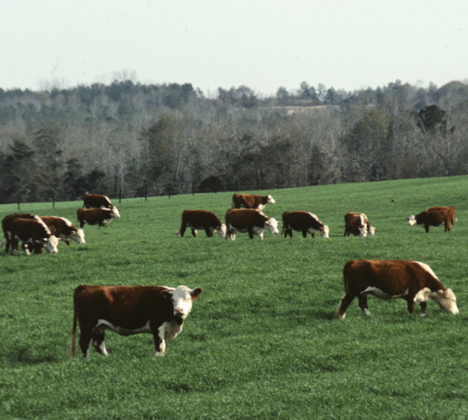
One of the biggest challenges associated with raising livestock is providing feed for them. For most livestock producers, continual striving to provide a long grazing season for their animals is highly beneficial. Doing this minimizes the amount of hay or other stored feed that will be needed. It is an objective that makes sense, and that should be a high priority objective. There are several reasons why this is the case.
*Having animals harvest their feed by grazing in pastures tends to be more environmentally sound because feeding hay or other stored feed materials concentrates animals and nutrients. When such materials are fed inside of a structure of some type, the manure that accumulates requires effort and expense to remove.
*When hay or other stored feed is fed to livestock in pastures, there still is concentration of nutrients in the spots where it is fed, and it typically results in hoof damage to pastures in the areas where hay or feeding troughs were placed. Conversely, when pasture forage is grazed, there is much more even distribution of the nutrients in dung and urine, and less damage caused by hoof action, especially when rotational stocking is used.
*It is more healthful for the animals to get their nutrition by grazing pasture forage. The greater extent to which animals are bunched together, the greater the likelihood of disease transmission, combative behavior, or inequal access to feed due to competition among animals.
*Weather is a major concern with production of hay (the most common stored feed), but a forage/livestock manager can have animals harvest pasture forage by grazing, almost without regard to weather.
*The forage quality of young, vegetative pasture growth or even leafy autumn residue is usually considerably higher than that of hay, which is produced by cutting older, and usually more fibrous, forage. In fact, if livestock have the opportunity, they will selectively graze the most palatable and nutritious plants and plant parts. Consequently, animal performance is typically better when livestock are grazing properly managed pastures as opposed to hay of the same species.
*Less labor is required to have animals graze rather than providing them with stored feed.
*While the value of this can’t be quantified and can only be estimated subjectively, another plus for pasture production is that many people find something attractive and satisfying about seeing animals grazing in a pasture. Evidence of this is that while pasture scenes are commonly displayed, one rarely sees pictures or paintings of animals in a feedlot or stable.
*A final point is of great importance. Reducing the amount of hay or other stored feed lowers expenses. In livestock budgets, stored feed accounts for a substantial amount of the cost of production. A review of 325 standardized performance analysis beef cow records on herds in Illinois and Iowa showed that feed cost was the main factor that determined profitability, explaining over 57 percent of herd-to-herd variability.
Stored feed is two to three times more expensive per animal or per day than pasture. The quantity of stored feed required is one of the best indicators of profitability for a livestock operation. In general, as the need for stored feed decreases, the economic the economic outlook becomes more favorable.
__________________
Foraging Ahead is a column presented by Ragan & Massey and written by Dr. Don Ball, Professor Emeritus at Auburn University. Dr. Ball is one of the authors of the popular book “Southern Forages,” which can be found via a computer search that uses the words, “Southern Forages, The Fertilizer Institute.”
